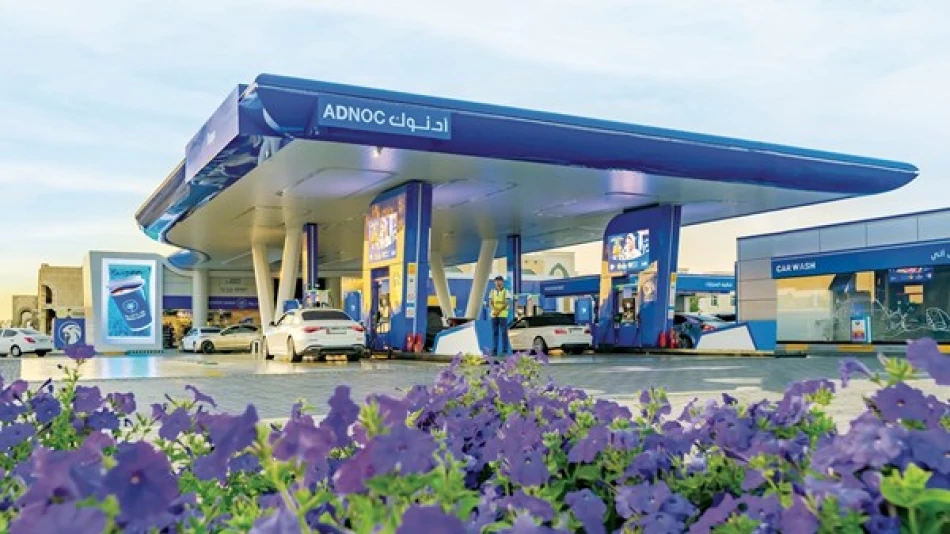
Adnoc's Soaring Profits: Unveiling Remarkable Half-Year Financial Results
ADNOC's Listed Companies Post Strong 7% Profit Growth Despite Energy Market Volatility
Six ADNOC subsidiaries traded on the Abu Dhabi Securities Exchange delivered collective profits of AED 17.47 billion in the first half of 2025, marking a solid 7.13% increase from the previous year. This performance underscores the UAE's strategic positioning as a resilient energy powerhouse, even as global commodity markets face headwinds and regional competition intensifies.
Energy Sector Leads the Charge
The standout performance came from ADNOC's energy-focused subsidiaries, which collectively grew profits by 13.5% to AED 14.48 billion. This growth trajectory reflects the UAE's calculated approach to energy diversification and operational efficiency improvements, positioning it favorably against regional competitors like Saudi Aramco's listed entities.
ADNOC Gas Maintains Momentum
ADNOC Gas, the group's largest profit contributor, posted net income of AED 9.75 billion—a 12% year-on-year increase. Notably, the company achieved this growth despite flat revenues of AED 44.36 billion, suggesting improved operational efficiency and cost management. This performance mirrors similar trends seen in Qatar's energy giants, where margin optimization has become crucial amid fluctuating global gas prices.
Distribution Network Shows Resilience
ADNOC Distribution's 12.2% profit growth to AED 1.336 billion, despite a 2.4% revenue decline, demonstrates the strength of the UAE's domestic fuel market and the company's pricing power. This contrasts sharply with distribution networks in other Gulf states, where margin compression has been more pronounced.
Mixed Signals from Petrochemicals
The petrochemical sector presented a more complex picture, reflecting global oversupply concerns that have plagued the industry since 2024.
Fertiglob Faces Headwinds
Fertiglob's 22% profit decline to AED 563.7 million, despite 20% revenue growth, highlights the challenging dynamics in global fertilizer markets. Rising input costs and intense competition from Russian and Chinese producers have compressed margins industry-wide. However, the revenue growth suggests strong underlying demand, particularly from emerging markets.
BOROUGE Navigates Volatility
BOROUGE's 18.3% profit drop to AED 1.74 billion reflects broader petrochemical sector challenges. The company's performance aligns with similar struggles faced by petrochemical giants globally, including those in Saudi Arabia and Singapore, where overcapacity continues to pressure margins.
Services Sector Delivers Strong Growth
ADNOC Drilling emerged as a standout performer with 21% profit growth to AED 2.541 billion, supported by robust 30% revenue expansion. This performance reflects the UAE's aggressive upstream investment strategy and the global uptick in drilling activity as energy companies rebuild production capacity.
Similarly, ADNOC Logistics & Services posted impressive 40% revenue growth, though profit growth remained modest at 5%. This suggests the company is investing heavily in capacity expansion to capture growing regional logistics demand.
Investment Implications
For investors, these results reinforce the UAE's position as a premium energy investment destination. The consistent profit growth across core energy operations, despite commodity price volatility, demonstrates operational excellence and strategic positioning. However, the petrochemical sector's struggles warrant caution, particularly as global capacity additions continue through 2025.
The strong performance also validates the UAE's IPO strategy, which has selectively listed profitable subsidiaries while maintaining state control over strategic assets. This approach has created attractive investment vehicles while preserving national energy security—a model increasingly studied by other Gulf states.
Looking Ahead
These first-half results position ADNOC's listed entities well for continued growth, particularly as global energy demand remains robust and the UAE's strategic investments in production capacity and efficiency begin to pay dividends. The challenge will be navigating ongoing petrochemical sector headwinds while capitalizing on the energy transition opportunities that favor gas and integrated energy companies.
 Layla Al Mansoori
Layla Al Mansoori







